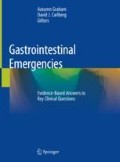Abstract
Cirrhosis occurs when damage to the liver results in scar tissue (hepatic fibrosis), affecting liver function. By the time cirrhosis is diagnosed or suspected based on stigmata of chronic liver disease (e.g., spider angiomas, jaundice, pruritis, palmar erythema) and laboratory abnormalities, approximately 30–40% of patients will have varices. Of those without varices at the time of diagnosis, another 10–15% will develop varices each year. Despite its probable safety based on small retrospective series, the decision to place an NGT for aspiration or lavage requires a careful assessment of the potential risks (e.g., bleeding, pain, aspiration, unclear prognostic and outcome value) and benefits (e.g., localization of bleed and assessment of active bleeding) of the procedure. Gastrointestinal bleeding in patients with cirrhosis is common and carries a high mortality rate of approximately 15–30%. Risk factors associated with early re-bleeding and poor outcomes include severe initial bleeding as defined by a hemoglobin less than 8 g/dL, gastric variceal bleeding, thrombocytopenia, encephalopathy, alcohol-related cirrhosis, large varices, and active bleeding during endoscopy. Antibiotics have a proven benefit in variceal bleeding with decreased morbidity and mortality. Vasoactive medications such as terlipressin a synthetic vasopressin not available in the United States, octreotide, and somatostatin have all been studied and found to have varied benefits in the treatment of variceal bleeding.
Access this chapter
Tax calculation will be finalised at checkout
Purchases are for personal use only
References
Kamath P, Shah V. Overview of cirrhosis. Chap 74: Sleisenger and Fordtran's gastrointestinal and liver disease. 1254–1260.e1.
Nable J, Graham A. Gastrointestinal bleeding. Emerg Med Clin. 2016;34(2):309–25.
Turan F, Casu S, Hernandez-Gea V, Garcia-Pagan J. Variceal and other portal hypertension related bleeding. Best Prac Res Clin Gastro. 2013;27:649–64.
Satapathy S, Sanyal A. Non-endoscopic management strategies for acute esophagogastric variceal bleeding. Gastroenterol Clin N Am. 2014;43(4):819–33.
Garcia-Tsao G, Sanyal A, Grace N, Carey W. Practice guidelines Committee of the American Association for the Study of liver diseases and the practice parameters Committee of the American College of Gastroenterology. Practice guidelines: Prevention and management of gastroesophageal varices and variceal hemorrhage in cirrhosis. Am J Gastroenterol. 2007;102:2086–102.
Haq I, Tripathi D. Recent advances in the management of variceal bleeding. Gastroenterology Rep. 2017;5(2):113–26.
Lopez-Torres A, Waye JD. The safety of intubation in patients with esophageal varices. Am J Dig Dis. 1973;18(12):1032–4.
Ritter D, Rettke S, Hughes R, Burritt M, Sterioff S, Ilstrup D. Placement of nasogastric tubes and esophageal stethoscopes in patients with documented esophageal varices. Anesth Analg. 1988;67:283–5.
Reverter E, Tandon P, Augustin S, Turon F, Casu S, et al. A MELD – based model to determine risk of mortality among patients with acute variceal bleeding. Gastroenterology. 2014;146:412–9.
Iino C, Shimoyama T, Igarashi T, Aihara T, Ishii K, Sakamoto J, Tono H, Fukuda S. Usefulness of the Glasgow Blatchford score to predict 1 week mortality in patients with esophageal variceal bleeding. Eur J Gastroenterol Hepatol. 2017;29(5):547–51.
Wells M, Chande N, Adams P, et al. Meta-analysis: vasoactive medications for the management of acute variceal bleeds. Aliment Pharmacol Ther. 2012;35:1267–78.
Fernandez J, Ruiz DA, Gomez C, Durandez R, Serradilla R, Guarner C, Planas R, Arroyo V, Navasa M. Norfloxacin vs ceftriaxone in the prophylaxis of infections in patients with advanced cirrhosis and hemorrhage. Gastroenterology. 2006;131:1049–56.
Gotzsche P, Hrobjartsson A. Somatostatin analogues for acute bleeding oesophageal varices. Cochrane Database Syst Rev. 2008;3:CD000193.
Villanueva C, Colomo A, Bosch A, et al. Transfusion strategies for acute upper gastrointestinal bleeding. N Engl J Med. 2013;368:11–21.
Author information
Authors and Affiliations
Corresponding author
Editor information
Editors and Affiliations
Rights and permissions
Copyright information
© 2019 Springer Nature Switzerland AG
About this chapter
Cite this chapter
Graham, A., Meltzer, A.C. (2019). End-Stage Liver Disease and Variceal Bleeding. In: Graham, A., Carlberg, D.J. (eds) Gastrointestinal Emergencies. Springer, Cham. https://doi.org/10.1007/978-3-319-98343-1_18
Download citation
DOI: https://doi.org/10.1007/978-3-319-98343-1_18
Published:
Publisher Name: Springer, Cham
Print ISBN: 978-3-319-98342-4
Online ISBN: 978-3-319-98343-1
eBook Packages: MedicineMedicine (R0)

